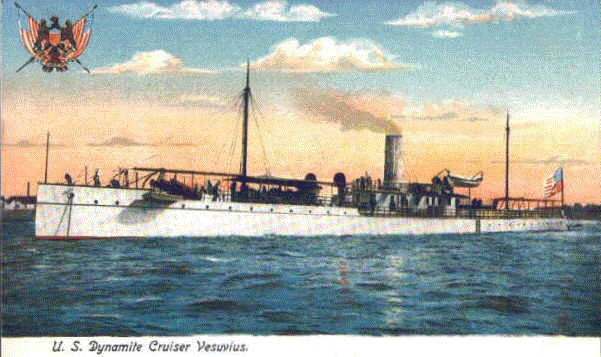
USS VESUVIUS

GENERAL:
The USS VESUVIUS was a one-of-a-kind experimental vessel that saw use in the War. No other vessels of this type were built. The unusual characteristic of the ship were the three 15" "dynamite" guns which constituted the ship's main battery.
BACKGROUND:
The authorization to build a dynamite gun cruiser was obtained on August 3, 1886. The vessel was very unusual and was studied by naval experts from around the world. It obtained a mixed, but generally negative review.
In theory, the Vesuvius could fire thirty projectiles consisting of five hundred pounds of gun cotton, dynamite of other high explosive in thirty minutes. The projectiles were fired from three 15 inch guns using compressed air, hence the name "pneumatic guns". The compressed air would create less of a shock on the projectile than would a normal explosive charge and would therefore have less of a tendency to prematurely explode the projectile, which generally carried nitrocellulose and nitroglycerine.
VESUVIUS joined the fleet on October 1, 1890, operating with the North Atlantic Squadron until decommissioned on April 25, 1895 for major repairs. Relaunched on January 12, 1897, she joined the Cuban Blockade on May 28, 1898. She performed various special duties, and served as a dispatch boat between Cuba and Florida into July. During the War, she conducted eight shore bombardments against Santiago and its defenses. Admiral Sampson claimed that the bombardments had "great effect".
In spite of Admiral Sampson's comments, the VESUVIUS was considered less than effective. She was taken out of service on September 16, 1898 and remained in the Boston Navy Yard until being converted to a torpedo testing vessel in 1904. Her "dynamite" guns were removed and she was outfitted with four torpedo tubes. She was recommissioned on June 21, 1905. VESUVIUS was again decommissioned on November 27, 1907 for repairs. Again recommissioned on February 14, 1910, she served in the vicinity of Newport, Rhode Island. VESUVIUS was decommissioned for the final time on October 21, 1921, and sold for scrap on April 21, 1922.
Congress authorized a second Dynamite cruiser of the VESUVIUS type on March 2, 1889. The authorization was contigent on the Secretary of the Navy being satisfied with the as yet uncommissioned VESUVIUS and her unique armament. This vessel was never built.
ADVANTAGES/DISADVANTAGES:
One major problem was that the "dynamite" guns were not located within a movable turret or swivel mounting. For the guns to be brought to bear on a target, the ship had to face the target bow on. Action against moving targets was therefore difficult, and the ship was itself at a disadvantage when operating against a traditionally armed vessel. The ship was virtually defenseless when retreating.
Secondly, the range of the main guns was not as great as many of the vessels it would operate against. Though it had good speed, the speed alone could not ensure its survival against at traditionally armed ship with guns of good range. The "dynamite" guns' range was not altered by changing the angle of the guns, but by altering the amount of compressed air used to fire the projectile.
The ship's guns did have a strong psychological effect. It could fire with almost no warning, since the pneumatic guns were very quiet. If the shells hit, they were devastating. The threat of the untried weapon alone gave it a psychological advantage.
Click Here for an account of VESUVIUS in action!
TECHNOTES:
| Classification: |
|
Dynamite Gun Cruiser |
|---|
| Keel Laid: |
|
September, 1887 |
|---|
| Launched: |
|
April 28, 1888 |
|---|
| Comissioned: |
|
June 7, 1890 |
|---|
| Recomissioned: |
|
January 12, 1897 |
|---|
| Armament: |
|
Three 15" pneumatically fired "dynamite" guns mounted |
|---|
|
|
forward, with a range 200 yards to one and a half miles. |
|---|
|
|
Ten shells were carried aboard in the magazine. |
|---|
|
|
Five 3 pounders |
|---|
|
|
One Colt Gatling Gun (for landing parties) |
|---|
| Contractor: |
|
Pneumatic Dynamite-Gun Co., New York. Construction |
|---|
|
|
subcontacted to William Cramp & Sons, Philadelphia. |
|---|
| Length: |
|
252 feet 4 inches |
|---|
| Beam: |
|
26 feet 5 inches |
|---|
| Mean draft: |
|
10 feet 7-1/2 inches |
|---|
| Max. draft fully loaded: |
|
11 feet 2-1/2 inches |
|---|
| Displacement: |
|
929 tons |
|---|
| Complement: |
|
6 officers and 63 crewmen, |
|---|
|
|
commanded by Lt. Cmdr. John E. Pillsbury. |
|---|
| Engine type: |
|
Four cylinder vertical triple expansion, 4,295 hp. Twin screw. |
|---|
| Boiler type: |
|
Two locomotive marine boilers. |
|---|
| Speed: |
|
21.6 knots |
|---|
| Coal bunker capacity: |
|
145 tons |
|---|
| Endurance @ 10 knots: |
|
1800 nautical miles |
|---|
| Armor: |
|
1/2 inch |
|---|
| Cost: |
|
$350,000 |
|---|
Sources used for this information (see Bibliography for full source list)
Clerk of Joint Comittee on Printing, "The Abridgement of Message from the President of the United States to the Two Houses of Congress", Washington: Government Printing Office, 1899. 4 vols. (all are documents relating to the war)
Krausz, John, ed., "U.S.S. Vesuvius", reprinted from Harper's Illustrated, 1891 in "How to Buy an Elephant", New York: Hawthorn Books, 1977, pp. 155-157.
Naval History Department, Navy Department, "Dictionary of American Naval Fighting Ships", Washington DC: Government Printing Office, 1959.
Wright, General Marcus J., "Official History of the Spanish American War", Washington; War Records Office, 1900.







